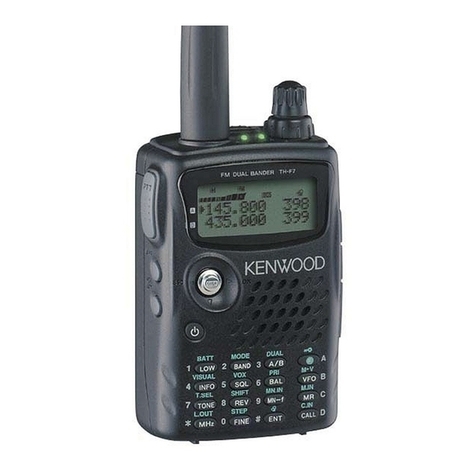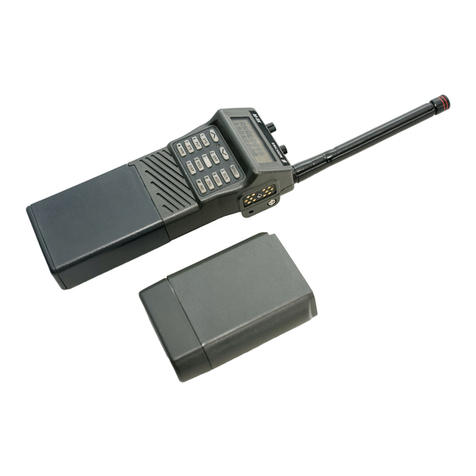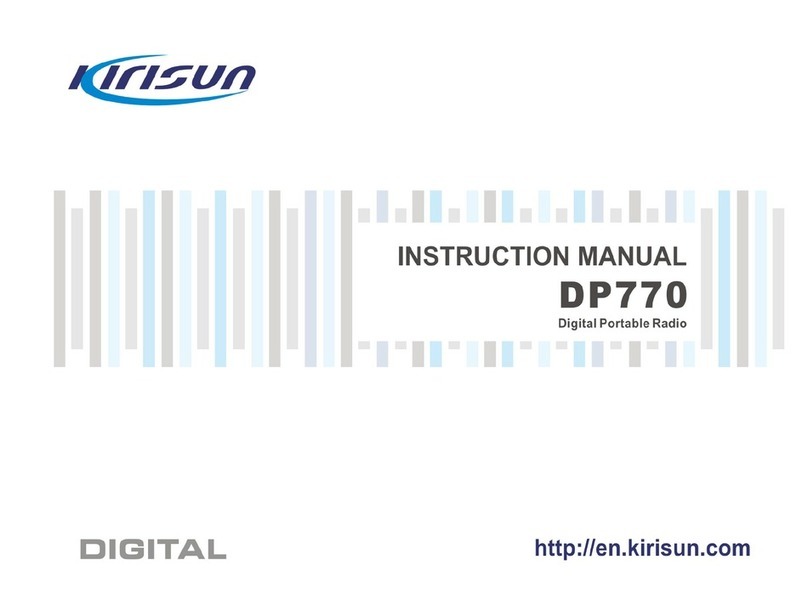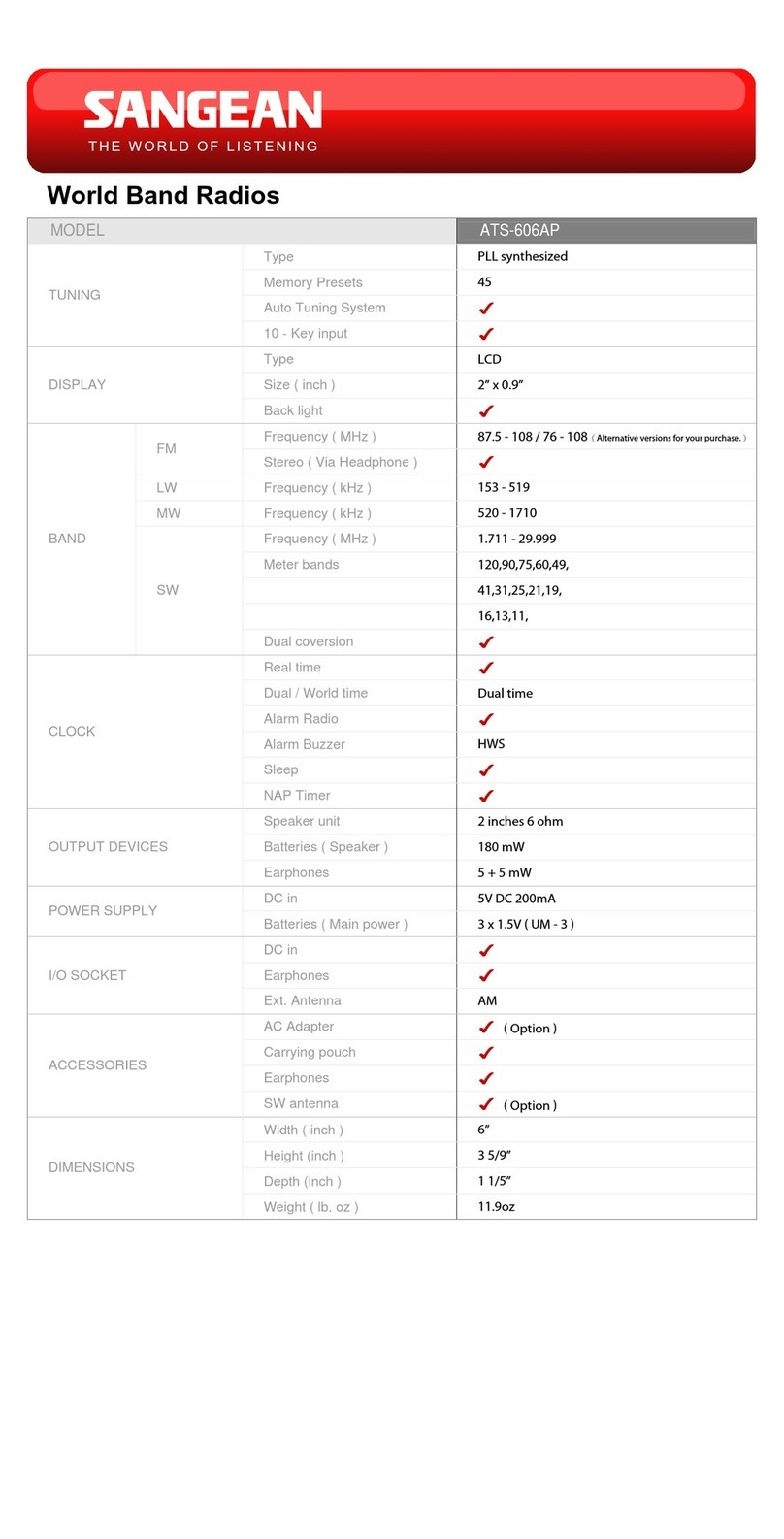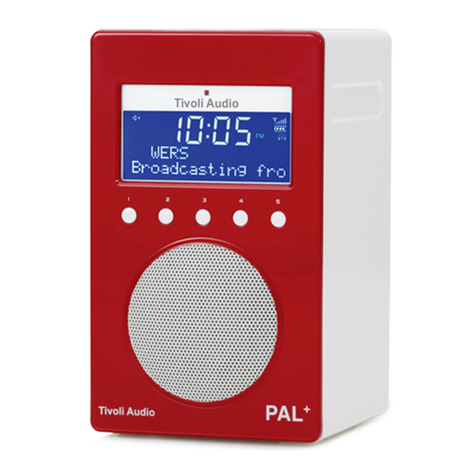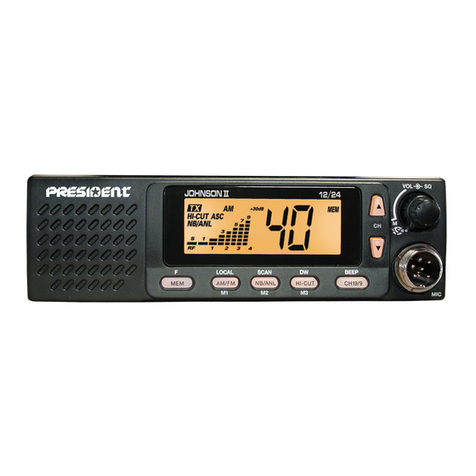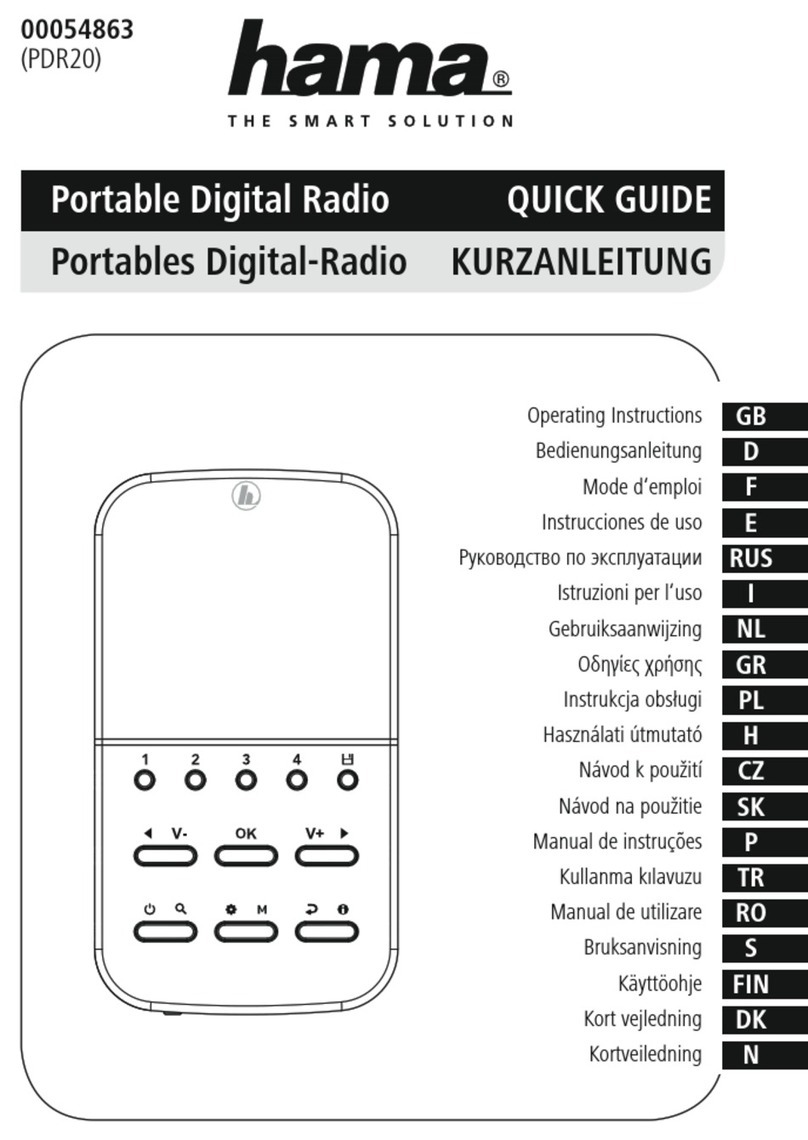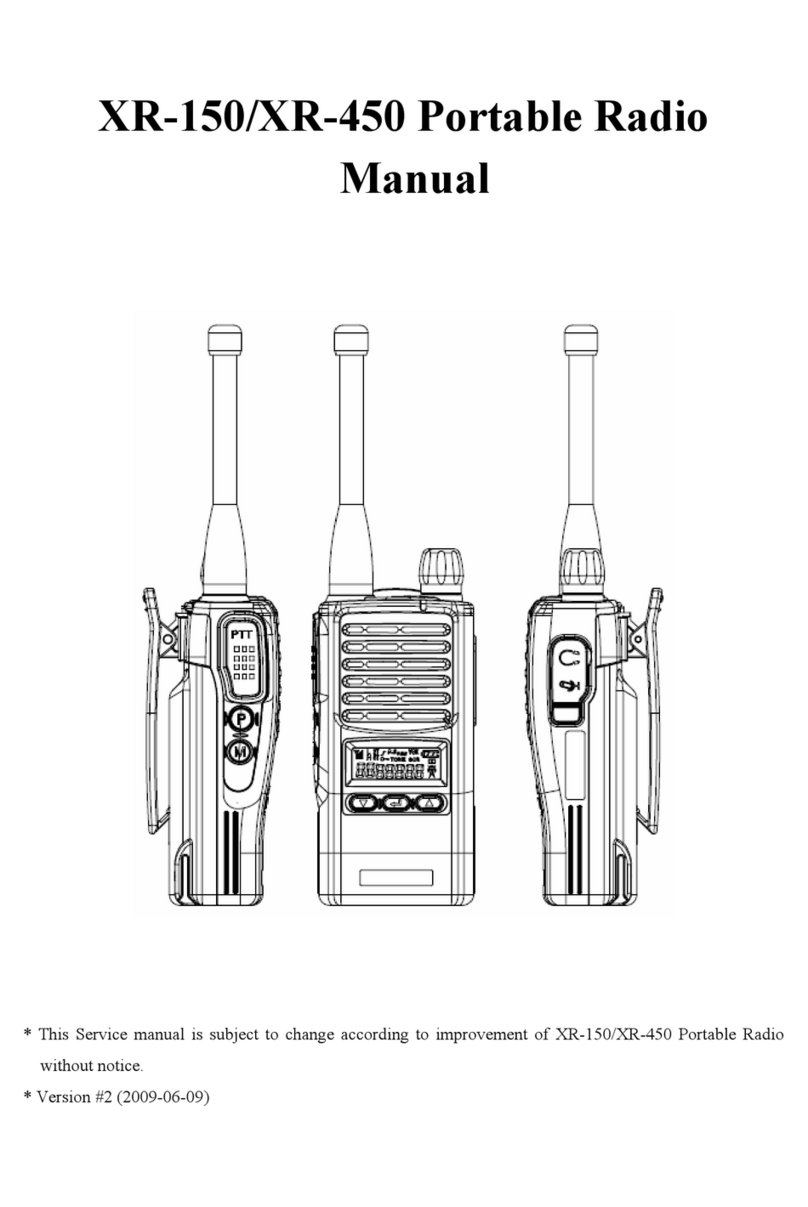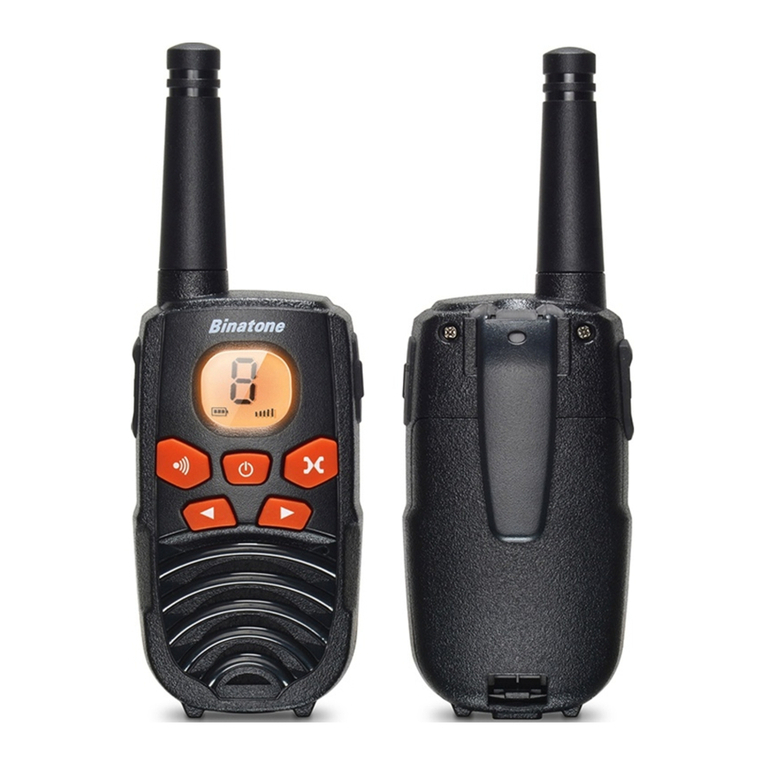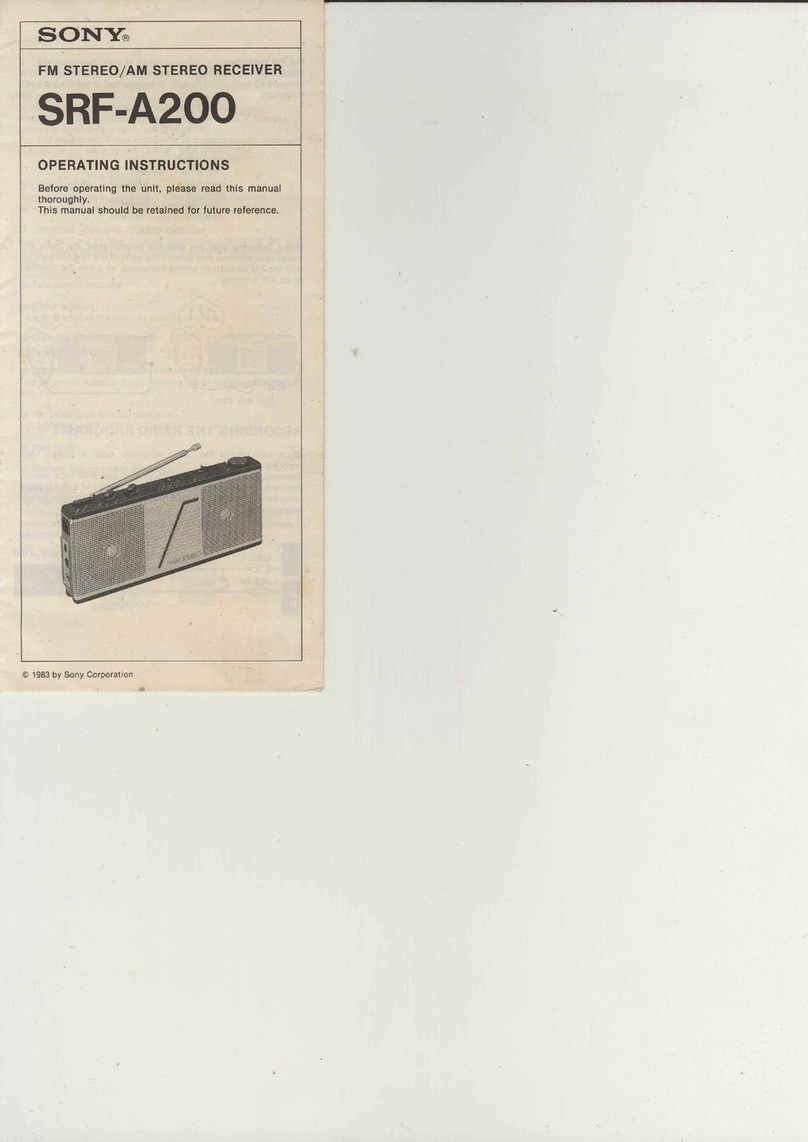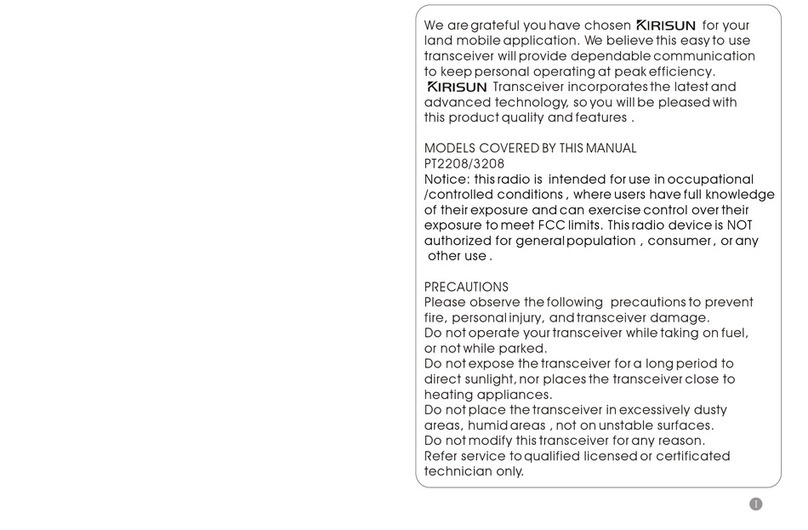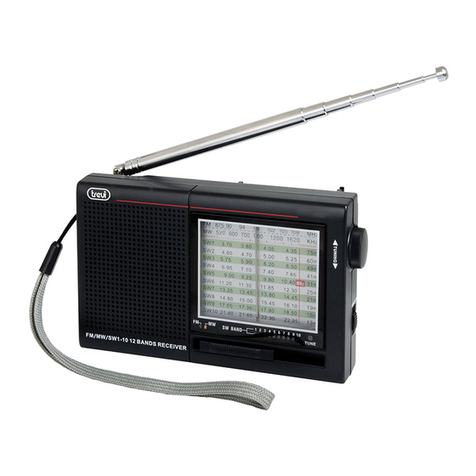Bose WRV5 User manual

The Bose
®
Wave
®
Radio
Owner’s Guide
October 17, 2001
AM255380_01_v.pdf

2 October 22, 2001 AM255380_01_V.PDF
Important Safety Information
WARNING:
To reduce the risk of fire or electric shock, do not
expose the Wave
®
radio to rain or moisture.
As with any electronic product, use care not to spill liquids into any
part of the radio. Liquids can cause a failure and/or a fire hazard.
These CAUTION marks are located on the bottom of your Wave radio:
The lightning flash with arrowhead symbol, within an equilateral triangle, is
intended to alert the user to the presence of uninsulated dangerous voltage
within the system enclosure that may be of sufficient magnitude to constitute a
risk of electric shock.
The exclamation point within an equilateral triangle, as marked on the system, is
intended to alert the user to the presence of important operating and mainte-
nance instructions in this owner’s guide.
CAUTION:
To prevent electric shock, match wide blade of plug to wide slot, insert fully.
ATTENTION:
Pour éviter les chocs électriques, introduire la lame la plus large de la fiche
dans la borne correspondante de la prise et pousser jusqu’au fond.
WARNING:
Keep the remote control battery away from children. It may cause a fire or chem-
ical burn if mishandled. Do not recharge, disassemble, heat above 100˚C (212˚F), or inciner-
ate. Dispose of used battery promptly. Replace only with a battery of the correct type and
model number.
WARNING:
No naked flame sources, such as lighted candles, should be placed on the
apparatus.
Batteries
Please dispose of used batteries properly, following any local regulations. Do not incinerate.
Please read this owner’s guide
Please take the time to follow this owner’s guide carefully. It will help you set up and operate
your radio properly, and enjoy all of its advanced features. Save your owner’s guide for future
reference.
Note:
DO NOT place the Wave radio on any heat-sensitive surface, such as the finished sur-
face of fine furniture. Like all electrical equipment, it generates some heat.
CAUTION
RISK OF ELECTRICAL SHOCK
DO NOT OPEN
CAUTION: TO REDUCE THE RISK OF ELECTRIC SHOCK,
DO NOT REMOVE COVER (OR BACK).
NO USER-SERVICABLE PARTS INSIDE.
REFER SERVICING TO QUALIFIED PERSONNEL.
AVIS
RISQUE DE CHOC ÉLECTRIQUE
NE PAS OUVRIR
ATTENTION : POUR RÉDUIRE LE RISQUE DE DÉCHARGE
ÉLECTRIQUE, NE RETIREZ PAS LE COUVERCLE (OU
L’ARRIÈRE). IL NE SE TROUVE ÀL’INTÉRIEURAUCUNE
PIÈCE POUVANT ÊTRE RÉPARÉE PARL’USAGER.
S’ADRESSER ÀUN RÉPARATEUR COMPÉTENT.

AM255380_01_V.PDF October 22, 2001 3
Important Safety Information
1. Read these instructions
– for all components before
using this product.
2. Keep these instructions
– for future reference.
3. Heed all warnings
– on the product and in the owner’s
guide.
4. Follow all instructions.
5. Do not use this apparatus near water or
moisture
– Do not use this product near a bathtub,
washbowl, kitchen sink, laundry tub, in a wet basement,
near a swimming pool, or anywhere else that water or
moisture are present.
6. Clean only with a dry cloth
– and as directed by
Bose
®
Corporation. Unplug this product from the wall
outlet before cleaning.
7. Do not block any ventilation openings. Install in
accordance with the manufacturer’s
instructions
– To ensure reliable operation of the
product and to protect it from overheating, put the
product in a position and location that will not interfere
with its proper ventilation. For example, do not place
the product on a bed, sofa, or similar surface that may
block the ventilation openings. Do not put it in a built-in
system, such as a bookcase or a cabinet that may keep
air from flowing through its ventilation openings.
8. Do not install near any heat sources, such as radi-
ators, heat registers, stoves or other apparatus
(including amplifiers) that produce heat.
9. Do not defeat the safety purpose of the polarized
or grounding-type plug. A polarized plug has two
blades with one wider than the other. A ground-
ing-type plug has two blades and a third grounding
prong. The wider blade or third prong are provided
for your safety. If the provided plug does not fit in
your outlet, consult an electrician for replace-
ment of the obsolete outlet.
10. Protect the power cord from being walked on or
pinched, particularly at plugs, convenience recep-
tacles, and the point where they exit from the ap-
paratus.
11. Only use attachments/accessories specified by
the manufacturer.
12. Use only with the cart, stand, tripod,
bracket or table specified by the
manufacturer or sold with the ap-
paratus. When a cart is used, use
caution when moving the cart/ap-
paratus combination to avoid injury
from tip-over.
13. Unplug this apparatus during lightning storms or
when unused for long periods of time
– to prevent
damage to this product.
14. Refer all servicing to qualified service personnel.
Servicing is required when the apparatus has
been damaged in any way: such as power-supply
cord or plug is damaged; liquid has been spilled or
objects have fallen into the apparatus; the appa-
ratus has been exposed to rain or moisture, does
not operate normally, or has been dropped
– Do not
attempt to service this product yourself. Opening or re-
moving covers may expose you to dangerous voltages
or other hazards. Please call Bose to be referred to an
authorized service center near you.
15. To prevent risk of fire or electric shock, avoid
overloading wall outlets, extension cords, or inte-
gral convenience receptacles.
16. Do not let objects or liquids enter the product
– as
they may touch dangerous voltage points or short-out
parts that could result in a fire or electric shock.
17. See product enclosure bottom for safety related
markings.
Information about products that
generate electrical noise
If applicable, this equipment has been tested and found to
comply with the limits for a Class B digital device, pursuant
to Part 15 of the FCC rules. These limits are designed to
provide reasonable protection against harmful interference
in a residential installation. This equipment generates, us-
es, and can radiate radio frequency energy and, if not in-
stalled and used in accordance with the instructions, may
cause harmful interference to radio communications. How-
ever, this is no guarantee that interference will not occur in
a particular installation. If this equipment does cause harm-
ful interference to radio or television reception, which can
be determined by turning the equipment off and on, you are
encouraged to try to correct the interference by one or more
of the following measures:
• Reorient or relocate the receiving antenna.
• Increase the separation between the equipment and
receiver.
• Connect the equipment to an outlet on a different circuit
than the one to which the receiver is connected.
• Consult the dealer or an experienced radio/TV technician
for help.
Note:
Unauthorized modification of the receiver or radio re-
mote control could void the user’s authority to operate this
equipment.
This product complies with the Canadian ICES-003 Class B
specifications

4 October 22, 2001 AM255380_01_V.PDF
Important Safety Information
18. Use proper power sources
– Plug the product into a
proper power source, as described in the operating in-
structions or as marked on the product.
19. Avoid power lines
– Use extreme care when installing
an outside antenna system to keep from touching pow-
er lines or circuits, as contact with them may be fatal.
Do not install external antennas near overhead power
lines or other electric light or power circuits, nor where
an antenna can fall into such circuits or power lines.
20. Ground all outdoor antennas
– If an external antenna
or cable system is connected to this product, be sure
the antenna or cable system is grounded. This will pro-
vide some protection against voltage surges and built-
up static charges.
Section 810 of the National Electrical Code ANSI/NFPA
No. 70 provides information with respect to proper
grounding of the mast and supporting structure,
grounding of the lead-in wire to an antenna discharge
unit, size of grounding conductors, location of antenna-
discharge unit, connection to grounding electrodes,
and requirements for the ground electrode. Refer to the
antenna grounding illustration on this page.
Antenna grounding
Example of antenna grounding as per National Electrical
Code, ANSI/NFPA 70.
Note to CATV system installer
This reminder is provided to call the CATV system installer’s
attention to Article 820-40 of the NEC (of USA) that provides
guidelines for proper grounding. In particular, it specifies
that the cable ground shall be connected to the grounding
system of the building, as close to the point of cable entry
as is practical.
Antenna lead-in wire
Antenna discharge unit
(NEC Section 810-20)
Grounding conductors
(NEC Section 810-21)
Groundclamps
Power service grounding
electrode system
(NEC ART 250, Part H)
Ground clamp
Electric service
equipment

AM255380_01_V.PDF October 22, 2001 5
Contents
Setting Up Your Wave
®
Radio
Before you begin . . . . . . . . . . . . . . . . . . . . . . . . . . . . . . . . . . . . . . . . . . . . . . . . . . . . . . . . . . . . 7
Unpacking the carton . . . . . . . . . . . . . . . . . . . . . . . . . . . . . . . . . . . . . . . . . . . . . . . . . . . . . . . . . 8
Selecting a location for your radio . . . . . . . . . . . . . . . . . . . . . . . . . . . . . . . . . . . . . . . . . . . . . . .8
Installing the battery . . . . . . . . . . . . . . . . . . . . . . . . . . . . . . . . . . . . . . . . . . . . . . . . . . . . . . . . . . 9
Connecting the power cord . . . . . . . . . . . . . . . . . . . . . . . . . . . . . . . . . . . . . . . . . . . . . . . . . . . . 10
Adjusting the antennas . . . . . . . . . . . . . . . . . . . . . . . . . . . . . . . . . . . . . . . . . . . . . . . . . . . . . . . . 10
Receiving cable radio signals as an option . . . . . . . . . . . . . . . . . . . . . . . . . . . . . . . . . . . . . . . . 10
Setting up the remote control . . . . . . . . . . . . . . . . . . . . . . . . . . . . . . . . . . . . . . . . . . . . . . . . . . 11
Connecting other components . . . . . . . . . . . . . . . . . . . . . . . . . . . . . . . . . . . . . . . . . . . . . . . . . . 13
Using other components . . . . . . . . . . . . . . . . . . . . . . . . . . . . . . . . . . . . . . . . . . . . . . . . . . . . . . 13
Operating Your Wave Radio
Operating the remote control . . . . . . . . . . . . . . . . . . . . . . . . . . . . . . . . . . . . . . . . . . . . . . . . . . . 15
Operating the radio control panel . . . . . . . . . . . . . . . . . . . . . . . . . . . . . . . . . . . . . . . . . . . . . . .16
Reading the clock display . . . . . . . . . . . . . . . . . . . . . . . . . . . . . . . . . . . . . . . . . . . . . . . . . . . . . 17
Setting the time . . . . . . . . . . . . . . . . . . . . . . . . . . . . . . . . . . . . . . . . . . . . . . . . . . . . . . . . . . . . . 17
Customizing the display . . . . . . . . . . . . . . . . . . . . . . . . . . . . . . . . . . . . . . . . . . . . . . . . . . . . . . . 18
Listening to the radio . . . . . . . . . . . . . . . . . . . . . . . . . . . . . . . . . . . . . . . . . . . . . . . . . . . . . . . . . 19
Reading the radio display . . . . . . . . . . . . . . . . . . . . . . . . . . . . . . . . . . . . . . . . . . . . . . . . . . . . . . 20
Setting the alarms . . . . . . . . . . . . . . . . . . . . . . . . . . . . . . . . . . . . . . . . . . . . . . . . . . . . . . . . . . . 21
Using the Alarms . . . . . . . . . . . . . . . . . . . . . . . . . . . . . . . . . . . . . . . . . . . . . . . . . . . . . . . . . . . . 22
Maintaining Your Wave Radio
Taking care of your Wave radio . . . . . . . . . . . . . . . . . . . . . . . . . . . . . . . . . . . . . . . . . . . . . . . . .23
Cleaning your radio . . . . . . . . . . . . . . . . . . . . . . . . . . . . . . . . . . . . . . . . . . . . . . . . . . . . . . . 23
Replacing the batteries . . . . . . . . . . . . . . . . . . . . . . . . . . . . . . . . . . . . . . . . . . . . . . . . . . . .23
Technical information . . . . . . . . . . . . . . . . . . . . . . . . . . . . . . . . . . . . . . . . . . . . . . . . . . . . . . . . . 23
Power rating . . . . . . . . . . . . . . . . . . . . . . . . . . . . . . . . . . . . . . . . . . . . . . . . . . . . . . . . . . . . . 23
Dimensions . . . . . . . . . . . . . . . . . . . . . . . . . . . . . . . . . . . . . . . . . . . . . . . . . . . . . . . . . . . . . 23
Weight . . . . . . . . . . . . . . . . . . . . . . . . . . . . . . . . . . . . . . . . . . . . . . . . . . . . . . . . . . . . . . . . . 23
Troubleshooting . . . . . . . . . . . . . . . . . . . . . . . . . . . . . . . . . . . . . . . . . . . . . . . . . . . . . . . . . . . . . 24
Customer service . . . . . . . . . . . . . . . . . . . . . . . . . . . . . . . . . . . . . . . . . . . . . . . . . . . . . . . . . . . . 24
Warranty period . . . . . . . . . . . . . . . . . . . . . . . . . . . . . . . . . . . . . . . . . . . . . . . . . . . . . . . . . . . . . 24
Index
Bose
®
Corporation Sales and Service
For your records
The serial number is located on the bottom of your radio.
Wave radio serial number: ____________________________
Purchase date: ______________________________________
We suggest you keep your sales receipt and warranty card together with this owner’s guide.

6 October 22, 2001 AM255380_01_V.PDF

AM255380_01_V.pdf October 22, 2001 7
Setting Up Your Wave
®
Radio
Before you begin
Thank you for purchasing the Bose
®
Wave radio.
Fourteen years of research by Bose Corporation bring you the benefits of award-winning pat-
ented acoustic waveguide speaker technology. Using this technology, a tube efficiently trans-
fers energy from a small loudspeaker to the outside air over a whole range of bass notes.
And, by folding long waveguides into intricate patterns, they fit into products small enough to
be placed comfortably in your home. There is a 37-inch (93.5-cm) long waveguide inside the
Wave radio’s enclosure, enabling this tabletop radio to produce room-filling sound with full,
deep bass.
Your Wave radio also includes:
•Integrated system design for high acoustic quality requiring no complex adjustments
•A high performance stereo tuner with 6 AM and 6 FM station presets
•Two independent alarms, with battery backup power to save the settings for wakeup during
power loss
•A credit card-size infrared remote control with optional mounting strip
•Inputs for an additional sound source, such as a CD or tape player
To fully appreciate all of these features, please take the time to follow this owner’s guide care-
fully. It helps you set up and operate your radio and enjoy its high-fidelity sound.

8 October 22, 2001 AM255380_01_V.pdf
Setting Up Your Wave
®
Radio
Unpacking the carton
Carefully unpack your system. Save all packing materials for possible future use. The original
packing materials provide the safest way to transport your Wave radio. If any part of the prod-
uct appears damaged, do not attempt to use it. Notify Bose
®
Customer Service immediately.
(See phone numbers on the inside back cover.)
Check to be sure your Wave radio contains the parts identified in Figure 1.
Note:
Find the serial number on the bottom of your radio. Write it on your warranty card and
in the space provided on page 5.
Figure 1
Carton contents:
• Wave radio
• Power cord
• 9V battery
• Remote control
• Lithium battery
• Mounting strip
Selecting a location for your radio
Please keep these guidelines in mind when selecting a location for your radio:
•Place the radio on a table or other flat surface.
•Do not place it on a metal surface or table that could interfere with AM reception.
•Do not place it on a heat-sensitive surface. Like all electrical equipment, it generates some
heat.
•To ensure reliable operation of the product and to protect it from overheating, put the prod-
uct in a position and location that will not interfere with its proper ventilation.
•Do not use the radio in a damp location. It is important to prevent moisture from getting into
the unit.
•Locate it within 2 feet (61 cm) of a wall for best bass performance.
•Place it across the room from where you will be listening to enjoy maximum performance of
the Wave radio.
Feel free to place and position it where you find the sound most pleasing.
Alarm Mode
Alarm
Set
Clock
Set
Presets
123
456
Tuning
Volume
Sleep/Snooze
AUX AM/FM On/Off
Wave Radio
Time
Alarm
Sleep
Tuning
Station
VolumeMute
AUXAM
FM
On
Off
123
456
Presets
Wave Radio
Remote
control
9V battery
Power cord
Mounting strip
Lithium
battery
Wave radio

AM255380_01_V.PDF October 22, 2001 9
Setting Up Your Wave
®
Radio
Installing the battery
WARNING:
Keep the remote control battery away from children. It may cause a fire or chem-
ical burn if mishandled. Do not recharge, disassemble, heat above 100˚C (212˚F), or inciner-
ate. Dispose of used battery promptly. Replace only with a battery of the correct type and
model number.
The 9V battery maintains clock and alarm settings and operates the Wave radio’s alarm sys-
tem for approximately 48 hours during a power loss, or while the radio is temporarily
unplugged. Operating without this battery results in the loss of clock and alarm settings, and
station presets in the event of a power loss, but does not harm the radio.
Use a standard 9V battery (IEC 6F22 in Europe), available at most retail stores.
Note:
The battery does not provide power for Wave radio operation or for the display.
1. Carefully turn your radio upside down.
2. Locate the battery compartment on the bottom (Figure 2).
3. Press the arrow on the cover to slide the compartment open.
4. Lift the battery clip out of the compartment and align it with the battery as shown.
5. Snap the terminals together firmly.
6. Place the battery in the compartment and slide the cover closed. Then turn the radio right
side up.
Figure 2
Installing the battery

10 October 22, 2001 AM255380_01_V.pdf
Setting Up Your Wave
®
Radio
Connecting the power cord
1. Untie and straighten the bundled power cord completely to ensure the best FM recep-
tion. The FM antenna is built into the power cord.
2. Plug the small end of the power cord into the power jack on the back of your radio (Figure
3). The connector is shaped to fit in only one direction. Line up the flat edge of the plug
with the flat edge on the side of the jack.
3. Plug the other end of the power cord into an electric outlet. The display panel lights and
the time display begins flashing.
4. Press the Clock Set button once to stop the flashing. See “Setting the time”on page 17
to set the clock.
Figure 3
Connecting the power cord
Adjusting the antennas
With the FM antenna built into the power cord, adjusting the cord position affects FM radio
reception slightly. With the AM antenna built into the radio, turning the radio more to one side
or the other adjusts AM reception slightly.
Receiving cable radio signals as an option
To connect your radio to the FM signal available from some cable TV companies, contact
your cable provider for assistance.
The cable screws onto threads of the FM 75
Ω
EXTERNAL antenna connector on the back of
the Wave radio (Figure 3). To make this connection easier, you may want to obtain a screw-on
to push-on RF adapter (available at electronic stores).
CAUTION:
Make sure the installation includes a signal splitter. It is important that only the FM
band, not the cable TV band, is transmitted to the radio. It is necessary to use a splitter that
filters the signal to prevent any re-emissions of the TV spectrum through the radio.
FM 75ΩEXTERNAL
antenna connector
Flat edge of connector
Straighten
power cord for
best FM reception

AM255380_01_V.PDF October 22, 2001 11
Setting Up Your Wave
®
Radio
Setting up the remote control
WARNING:
Keep the remote control battery away from children. It may cause a fire or chem-
ical burn if mishandled. Do not recharge, disassemble, heat above 100˚C (212˚F), or inciner-
ate. Dispose of used battery promptly. Replace only with a battery of the correct type and
model number.
Your remote control may be one of two types. Each is identified by the way the battery com-
partment unlocks to install or replace the battery (Figure 4 or Figure 5).
1. Place the remote control face down on a flat surface.
2. If your remote has a slot on the back (Figure 4), follow step A. Otherwise, follow step B
and refer to Figure 5:
A. Insert the tip of a ballpoint pen into the slot. Push to the side as shown and hold.
Slide the battery compartment open with your finger.
B. Using your finger, push the tab lock to the side as shown and hold. Slide the battery
compartment open.
Figure 4
Locating the slot-type
safety lock
Figure 5
Locating the tab-type safety
lock
See operating
instructions for types of
battery to be used
See operating
instructions for types of
battery to be used
Slot
+ Symbol
See operating
instructions for types of
battery to be used
Tab
See operating
instructions for types of
battery to be used
+ Symbol

12 October 22, 2001 AM255380_01_V.pdf
Setting Up Your Wave
®
Radio
Note:
Use only a Duracell, Eveready, Maxell, or Toshiba CR2032 or DL2032 lithium battery
(available at electronics stores). If you have difficulty finding a replacement battery, contact
Bose
®
Customer Service. (See phone numbers on the inside back cover.)
3. Keeping the remote control face down, insert the new battery into the compartment with
the + symbol facing up.
4. Gently slide the battery compartment closed. It locks automatically.
5. Use the supplied mounting strip if you want to attach the remote to a surface in your lis-
tening room. Peel off the protective backing to stick one piece to the back of the remote
and the other to the selected surface (Figure 6).
Figure 6
Installing the mounting strip
for the remote control
CAUTION: Danger of explosion if battery is incorrectly replaced. Replace only with the same
or equivalent type.
See operating
instructions for types of
battery to be used

AM255380_01_V.PDF October 22, 2001 13
Setting Up Your Wave®Radio
Connecting other components
You can use your Wave radio to improve the sound of a CD player, tape player, or TV. You can
also use your radio as extension speakers for a Bose®Lifestyle®music system. Connect one
of these components to the right and left AUX IN jacks.
To play your radio through external speakers, connect Bose powered speakers to the radio’s
right and left VARIABLE OUT jacks. Audio cables for these connections are available at elec-
tronics stores, or by calling Bose Product and Technical Support.
Most audio cables are color coded. Match the red plug to the R (red) jack and the black or
white plug to the L (white) jack (Figure 7).
Note: Connecting components or speakers to the VARIABLE OUT jacks shuts off the radio
speakers.
Figure 7
Connecting another com-
ponent
Using other components
Select your CD player, tape player, or other auxiliary source by pressing the AUX button.
Adjust the listening volume with the Volume buttons. Control all other functions, including on/
off, at the source, referring to its owner’s manual, if necessary.
Control your auxiliary powered speakers from the Wave radio. If these speakers have a vol-
ume control, you may use it.
Note: Recording from your Wave radio is not recommended. Connecting a tape recorder to
the VARIABLE OUT jacks shuts off the radio speakers, preventing you from monitoring the
recording volume.
R
AUX IN
L
VARIABLE OUT

14 October 22, 2001 AM255380_01_V.pdf
Setting Up Your Wave®Radio
Component Cable
Connection at
component
Connection at
Wave radio Notes
Portable CD or tape
player
One miniplug-to-stereo
audio cable
Headphone jack
For best sound, set
the player volume
control to approxi-
mately 3/4 of maxi-
mum volume.
AUX IN jacks
CD player, tape deck,
or VCR
One stereo audio cable Audio output jacks
If there are two sets
of outputs (fixed and
variable), use fixed so
that the volume can
be controlled from the
radio.
AUX IN jacks Recording from your Wave radio is
not recommended because con-
necting cables to the VARIABLE
OUT jacks shuts off the radio
speakers, preventing you from
monitoring the recording volume.
Television Use a standard RCA
cable for a TV with stereo
output jacks.
Use a standard “Y”
adapter for a TV with a
single (mono) audio out-
put jack.
You may need a special
adapter (such as a
miniplug stereo audio
cable) for a TV with a
headphone outlet.
Audio output jacks
If there are two sets
of outputs (fixed and
variable), use fixed so
that the volume can
be controlled from the
radio.
AUX IN jacks To make sure the sound seems to
come from the screen, place the
Wave radio close to the TV.
Bose®Lifestyle®
music system
Stereo cable with male-
to-male RCA plugs.
TAPE (REC) jacks AUX IN jacks
Powered speakers
with volume control
Use the audio input
cable that came with
your speakers.
Speaker system input
(as described in the
speaker owner’s
guide)
VARIABLE OUT jacks If your powered speaker audio
input cable has three connectors
on each end, use only the two
connectors that look alike to con-
nect to the Wave radio outputs.
DO NOT USE THE THIRD CON-
NECTOR.
Connecting powered speakers to
the VARIABLE OUT jacks shuts
off the radio speakers.
RL
AUX IN
RL
AUX IN
RL
AUX IN
®
RL
AUX IN
VARIABLE OUT

AM255380_01_V.PDF October 22, 2001 15
Operating Your Wave®Radio
Operating the remote control
You can use the remote control (Figure 8) to operate the most frequently used functions of the
radio and alarms. Aim the remote control at the display of your Wave radio. Use the remote
buttons in the same way you use the radio control panel. The remote normally works up to 20
feet (6.1 m) in front of the radio, and 6 feet (1.8 m) to either side. Replace the remote control
battery when it stops operating, or its range seems reduced (normally every year or two).
Keep in mind that lighting and other room conditions, in addition to battery age, can affect the
operating range of an infrared remote control.
Figure 8
The Wave radio remote
Time Alarm Sleep
Tuning Station
Volume Mute
AUX AM
FM
On
Off
Wave Radio
123
456
Presets
Set or check the
wakeup time Selects radio, tone,
both, or no alarm
Tunes up or down
the AM or FM band
Turns on and stores
or selects a preset
station
Raises or lowers
volume
Turns the radio on
and selects AUX
Sets timed shutoff
Displays current station
Mutes/unmutes the radio
Turns the radio on/off,
deactivates the alarm
Turns the radio on and
selects AM or FM

16 October 22, 2001 AM255380_01_V.PDF
Operating Your Wave®Radio
Operating the radio control panel
Most of the functions of the clock and the radio are operated by similar buttons on the control
panel or the remote control (Figure 9). You can access additional functions by pressing two
control panel buttons simultaneously (such as both Tuning buttons to display the station),
which requires a separate button on the remote (Station).
The control panel On/Off and VOLUME buttons have raised ridges to help you locate these
frequently used buttons.
Figure 9
The Wave radio control
panel
Alarm Mode
Alarm
Set
Clock
Set
Volume
Presets
123
456
Tuning
Sleep/Snooze
AUX AM/FM On/Off
Wave Radio
Selects radio, tone,
both, or no alarm
Sets or checks the
wakeup time
Turns on and stores
or selects a preset
station
Raises or lowers
volume
Turns the radio on
and selects AUX
Sets the time
Tunes the radio; displays
the current station when
pressed together
Turns the radio
on and selects
AM or FM
Turns the radio on/off,
deactivates the alarm
Sets timed shutoff

AM255380_01_V.PDF October 22, 2001 17
Operating Your Wave®Radio
Reading the clock display
You can set the Wave radio to always show either the clock display (Figure 10) or the radio
display when the radio is on.
To change the display mode, press and hold Clock Set, and then press the AM/FM button.
To make additional changes to the display, see “Customizing the display”on page 18.
Figure 10
The clock display
Setting the time
SLEEP
PM
ALARM
ALARM 2
AM
Shows current time, wakeup time, sleep time,
station frequency, or volume setting Indicates ALARM is
set for radio alarm Indicates ALARM
is selected
Indicates ALARM is
set for tone alarm
Indicates ALARM 2
is selected
Indicates sleep mode Indicates AM or PM Indicates ALARM 2 is
set for radio alarm
Indicates ALARM 2 is
set for tone alarm
Function Control panel Remote control
To set the clock – Hold down the Clock
Set button and press Tuning up (4) or down
(3). The time display changes slowly at first,
then faster. Release the Tuning button to stop.
Use the control panel
to select this feature.
AlarmMode
Alarm
Set
Clock
Set
Volume
Presets
123
456
Tuning
Sleep/Snooze
AUX AM/FM On/Off
Wave Radio
Time Alarm Sleep
Tuning Station
Volume Mute
AUX AM
FM
On
Off
Wave Radio
123
456
Presets
Tuning
Clock
Set

18 October 22, 2001 AM255380_01_V.PDF
Operating Your Wave®Radio
Customizing the display
Function Control panel
To set AM/PM (12 hour) or Military (24 hour) time – Press
the On/Off button once to turn your Wave radio off.
Press and hold Clock Set, and then press On/Off to switch between
AM/PM (12 HR) or military (24 HR) formats
To set the display to clock or radio mode – In the clock
mode, the display shows the time while the radio is on; In radio mode,
the display shows the selected radio station.
With the radio turned on, press and hold Clock Set and then press the
AM/FM button to switch between clock and radio modes.
To adjust the display brightness – In low light situations, the
display dims automatically.
To adjust the brightness level for the automatic dim setting:
• Hold down the Clock Set button while pressing Volume up to view
the 10 levels of increasing brightness.
• Hold down the Clock Set button while pressing Volume up or down
to select you preferred setting.
The selected setting is retained by the radio with the 9V battery as
backup in case of power loss.
AlarmMode
Alarm
Set
Clock
Set
Volume
Presets
123
456
Tuning
Sleep/Snooze
AUX AM/FM On/Off
Wave Radio
Clock
Set
On/Off
On/Off
and
Clock
Set
AM/FM
and
Clock
Set
Volume
and

AM255380_01_V.PDF October 22, 2001 19
Operating Your Wave®Radio
Listening to the radio
Function Control panel Remote control
To turn on/off – Press once to turn on (to the last source played) or off. Or,
press AM/FM or any Presets button to turn the radio on.
To adjust the volume – While the radio is either on or off, press and hold
either button to adjust the volume. The display shows the volume level, from
0 (silent) to 99 (loud).
To select AM or FM – If the radio is off or in the AUX mode, press to
select the radio. Press again to change between AM and FM.
To tune in a station – Press and hold either button until the desired sta-
tion is selected.
To seek a station – Press and hold either button until you hear a beep.
Release to find the next strong station.
To preset up to 6 AM and 6 FM stations – Use the Tuning buttons to
find the desired station. Then hold down any Presets button until you hear a
beep. The station is now preset to that number.
To select a preset station – Choose AM or FM. Press the Presets but-
ton for the station you want.
To display the selected station – If the display is in clock mode and
the radio is on, press both Tuning buttons (control panel) together or press
Station (remote).
To mute the sound – On the remote control ONLY, press to silence the
radio. Press again to restore volume.
Use the remote control to
select this function.
To listen to a component connected to AUX – Press to turn on the
radio in AUX mode. This does not turn on the component.
To go to sleep listening to music – Press Sleep to set the automatic
shutoff time. Initially, the display shows you the first setting of 75 minutes.
Press again to change the automatic shutoff time to 60, 45, 30, 15, 10, 5, or
0.
AlarmMode
Alarm
Set
Clock
Set
Volume
Presets
123
456
Tuning
Sleep/Snooze
AUX AM/FM On/Off
Wave Radio
Time Alarm Sleep
Tuning Station
Volume Mute
AUX AM
FM
On
Off
Wave Radio
123
456
Presets
On/Off
On
Off
Volume
Volume
AM/FM
AM
FM
Tuning
Tuning
Tuning
Tuning
Tuning
123
456
Presets
123
456
Presets
Tuning
123
456
Presets
AM/FM
123
456
Presets
AM
FM
Tuning
Station
Mute
AUX
AUX
Sleep/Snooze
Sleep

20 October 22, 2001 AM255380_01_V.PDF
Operating Your Wave®Radio
Reading the radio display
You can set the Wave radio to always show either the clock display or the radio display (Fig-
ure 11) when the radio is on.
To change the display mode, press and hold Clock Set, and then press the AM/FM button.
To make additional changes to the display, see “Customizing the display”on page 18.
Figure 11
The radio display
AUX FM
STEREO
VOL AM
SEEK
PRESET 1 2 3 4 5 6
Indicates FM
stereo broadcast
Indicates
volume setting
is displayed
Indicates radio
is searching for the
next strong station
Indicates a preset
station is set Indicates the selected
preset station
Indicates the selected
sound source Shows station frequency, current time,
wakeup time, sleep time, or volume setting
This manual suits for next models
1
Table of contents
